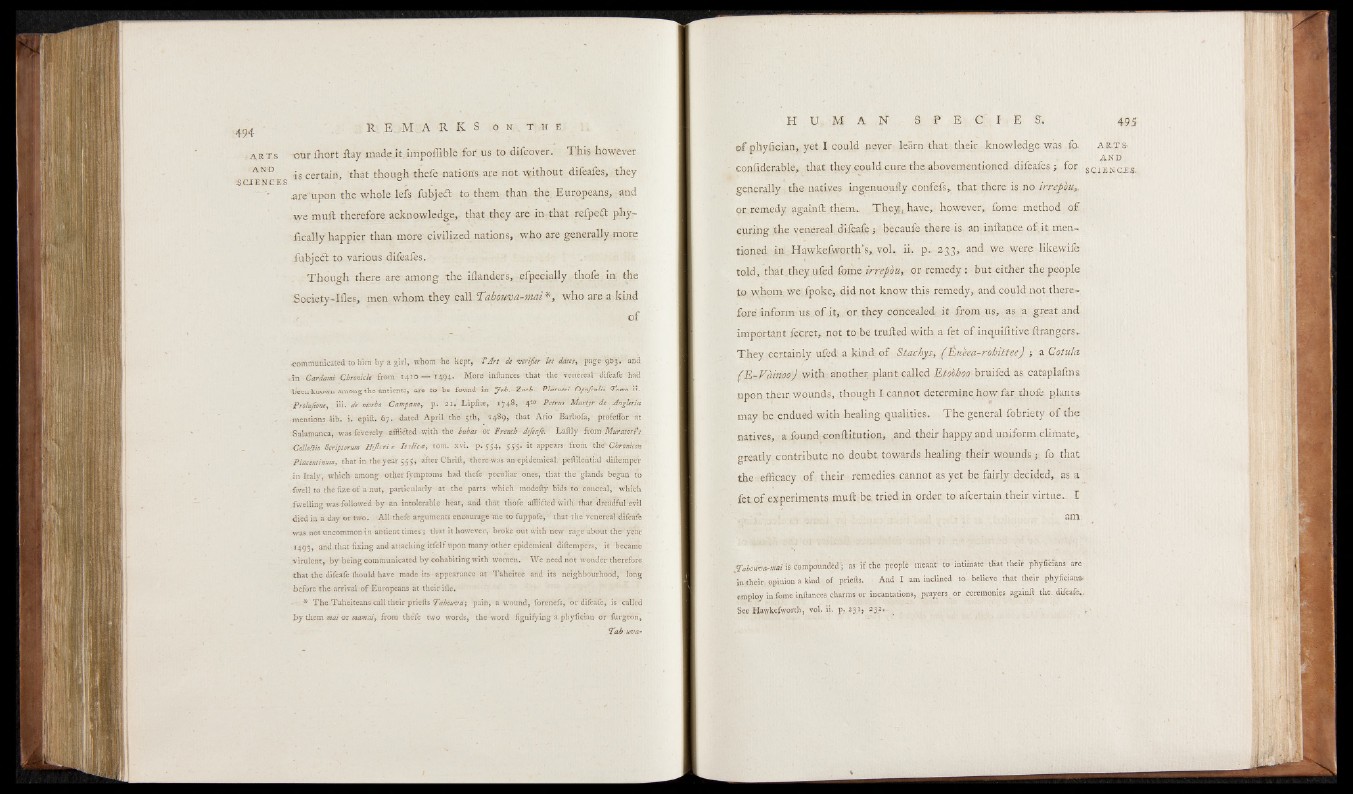
-ARTS
AND
SCIENCES
our fhort flay made.it impoffible for us to difeover. This however
is certain, that though thefe nations are not without difeafes, they
are "Upon the whole lei's fubjedt to them than the. Europeans, and
we mud therefore acknowledge, that they are in that refpedt phy-
iically happier than more civilized nations, who are generally more
fubjedt to various difeafes. '
Though there are among the iflanders, efpecially thofe in; the
Society-Ifles, men whom they call Tahouva-mai *, who are a kind
o f
communicated to him by a girl, whom he kept, F Art de verifier les dates, page 9.O3. and
.in Cardami Chronicle from 1410 — 1494. More inftances that the Venerea! difeafe had
iteen known among the antients, are to be found in Job. Zach. Pldtneri Ofu/culis Torn ii.
-Proluftone, iii. de rrtorbo Camfano, p. 2X. Lipfias, 1748, 4W Petrus Martyr de - Angleria
-mentions lib. i. epift. 67. dated April the 5th, 1489, that Ario Barbofa, profeflor at
Salamanca was -feverely afflicted with th e babas or French dtfeafe. Laftly from' Mur atari's
Colleaio Scriptorum Hifitrie Italic*, tom. xvi. p.554, it appears- from thfFCbronicoii
Placentinum, that in the year 5^5* after Chrift, there-was an epidemical, peftilential diftempe'r
,in Italy, which among other fymptoms had thefe peculiar ones, that the glands began to
-fwell to the fize of a nut, particularly at the parts which modefty bids to conceal, whifch
fwellinT was followed by an intolerable heat, and that thofe affli&ed with that dreadful evil
■ died in a day or two. All thefe arguments encourage me to fuppofe, that the venereal difeafe
was not uncommon in antient times; that it however, broke out with new rage about the year
1493, and that fixing and attaching itfelf upon many other epidemical diftempers, it became
virulent, by being communicated by cohabiting with women. We need not wonder therefore
that the difeafe Ihould have made its - appearance at Taheitee and its neighbourhood, long
before the arrival of Europeans at their Hie.
• ■ * The Taheiteans call their priefts Takouva; pain, a wound, forenefs, or difeafe, is called
by them mai or marnai, from the'fe two words, the word fignifying a phyfician Or furgeon,
Tab.uva-
If
of phyfician, yet I could never learn that their knowledge was fa arts.
A.'..' . AND
confiderable, that they could cure the abovementioned difeafes ; for s c 1E N C e 3 .
generally the natives ingenuoufi-y confefs, that there is no irrepou,,
or.remedy againft them. Th e y , have,, however,, feme method of
curing the venereal difeafe } becaufe there is an inflaoce of.it mentioned
ill Hawkefworth’s,, vol. ii. p . 233, and we were likewife
told, that , they .ufed feme irrepou, or remedy : but either the people
to whom we fpoke, did not know this remedy, and could not therefore
inform us of i t , . or they concealed, it from us, as a great and
important fecret,, not to be trailed with, a fet o f inquiiitive ilrangers.
Th e y certainly ufed. a kind of Stachys, (EnPea-rohittee), j a Copula
(E-Fainoo) with another plant called Etophoa bruifed as cataplafms.
upon their wounds, though I cannot determine how far thofe planta
may be endued with healing qualities. T h e general fobriety of the
natives, a found-eonftitution, and their happy and uniform, climate,,
greatly contribute no doubt towards healing their wounds;. fe that
the efficacy of their remedies cannot as yet be fairly decided, as a
fet o f experiments muil.be tried in order, to afeertain,their virtue.. I
am.
Taboima-wm is compounded ; as if the people meant to-intimate that theii pKyficrans are-
in their opinion a kind of priefts. ■ And I am inclined to believe that their phyfician®
employ in fome inftances charms or incantations, prayers or ceremonies againft the. difeafe..
See Hawkefworth, vol. ii. p. 231, 232.. ,